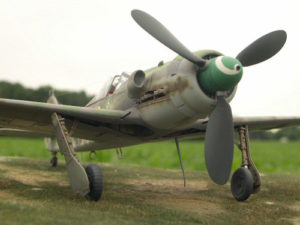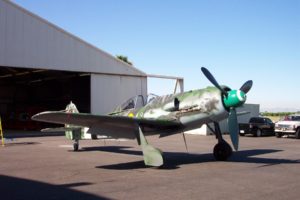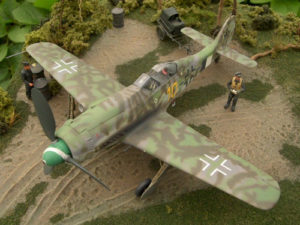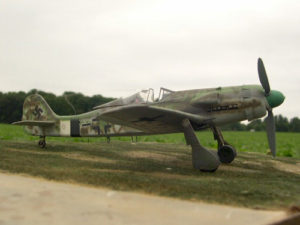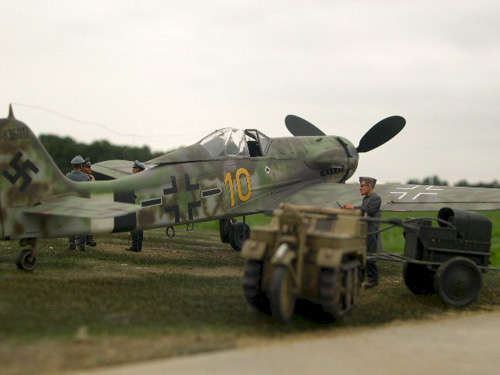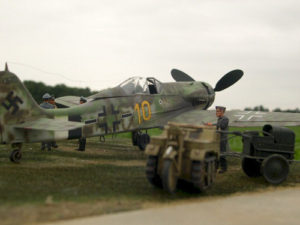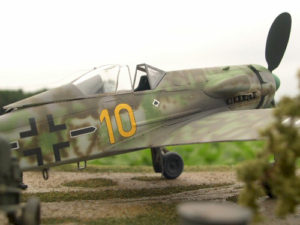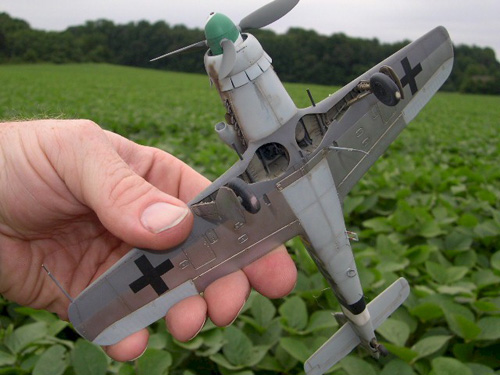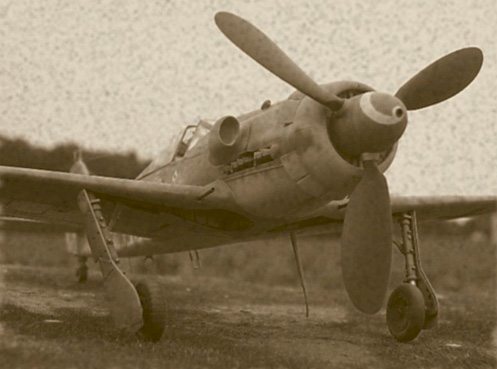
Model of FW 190 “Yellow 10”
by Floyd Werner
Here is my latest creation, the Tamiya/Wurger Mechanic FW-190D-13. The only thing that is Tamiya are the wings, landing gear and horizontal tail. The rest is the Wurger Mechanic full fuselage conversion with the Parts-R-Parts engine plug and wheel well, Aires cockpit, EagleCal decals. I can only tell you that I thoroughly enjoyed this build. What a great conversion. Floyd Werner
Tamiya/Wurger Mechanic FW-190D-13
By Floyd S. Werner, Jr. IPMS# 26266
The History
The history of the FW-190 is well documented so I will just concentrate on the D-13. The D-13 was a further development of the basic D-9. Re-engined with the Jumo 213, the D-13 required a larger supercharger intake, the same type used by the Ta-152. The engine was physically larger and this necessitated a larger engine cowling with a bulge. It is difficult to see with the camouflage but on the naked model the bulge is readily apparent. With the deletion of the upper guns the upper cowl was streamlined and flattened. The other obvious external difference is the single shell ejection port between the wheel wells. The props were larger with the adoption of the VS 9. The prop spinner was different in that it had an opening for the engine mounted 20mm. As compared with the D-9, the fuel filler access panel was mounted in a lower position and the engine primer hole was slightly higher.
In March through May 1945 JG26 was to be reequipped with the D-12, but the D-13 was substituted because the D-12 was cancelled. The D-12 was the same as the D-13 except for the engine armament. The D-12 carried the Mk108 while the D-13 carried the MG 151. Current indications are that there were at least two D-13s delivered to JG26. As far as I know there are no known photos of the other D-13, leaving Yellow 10 as the only photo documented aircraft.
Yellow 10 was the personal mount of Oblt. Franz Goetz, the commander of JG26. It was surrendered to the British at Flensberg. It was decided to evaluate the aircraft in the USA. The aircraft was shipped out on the HMS Reaper and the aircraft was evaluated at Freeman Field and then sent out for scrap. The aircraft was saved from the scrap heap and after various owners it now resides in Seattle full restored to its former glory. After seeing the aircraft in the color photos, some of which were published on Hyperscale by me via Jim Anderson, I knew that I wanted to take a shot at that camouflage.
The Model
The Tamiya kit is typical Tamiya, molded in light grey plastic with excellent detail. One thing that Tamiya did wrong was they patterned the D-9 after the Air Force Museum’s FW-190D-9 which had the wrong lower wing. The wing actually belonged to the D-13 at that time in the Champlin Fighter Collection. This actually works out for you as you will want the single chute ejection port for the D-13. Tamiya fixed the area on the JV44 issue, which has the correct D-9 center wing section. One thing that is incorrect on both kits is the wheel well area. The area should be open to allow the engine to be seen from underneath. There has been talk of landing gear being too short, spinner too small and some other nitnoid things. Bottom line it is still the easiest D-9 to build and it “looks” like a D-9.
For the D-13 most of the inaccuracies are taken care of by the Wurger Mechanic with their full fuselage conversion. I can not tell you how much I loved this set. OH MY GOD, it is soooo sweet! The conversion comes with a complete resin fuselage that is absolutely flawless and very hollow (spin casting?). If you didn’t know it was resin you would swear it was plastic. The only cleanup required is the pour plugs on the ultra thin tail. Careful sanding and carving will allow a perfect fit. Again, you would have thought it was a Tamiya kit part. In addition to the fuselage, you get a new oil cooler and cowl, spinner, prop blades (including separate hubs), upper cowling, separate wheel centers, and three wheels. This set is so well researched that you are given two “normal” treaded tires and one “smooth” tire. Wurger Mechanic points out that the left tire appears to be the smooth tread type in photos, I agree. I can’t tell you how nice everything fit. There was no need for filler anywhere. Other than having to assemble with superglue the conversion is easy to use.
The Aires Cockpit
The kit cockpit is nice but I had the Aires set and thought it was better than what Tamiya offered. Let me say that there really isn’t anything wrong with the Tamiya cockpit but the detail is nicer in the Aires set. The Aires cockpit was assembled as per the instructions with no problems. It fit like a champ, even with the engine plug. I did have to sand it at the front slightly for a perfect fit.
The cockpit was sprayed RML 66 and given a wash of black artist oils. Once dry the assembly was dry brushed with RLM 02 and some silver. The seatbelts were painted in Polly-S Dirty White with silver buckles and washed in burnt umber artist oils.
Parts-R-Parts Engine Plug
The other thing the kit needs is an engine plug. Parts-R-Parts provide you with a specific engine model. The D-9 and the D-11/12/13 engine plugs are different. Have I mentioned that I really love the Wurger Mechanic fuselage? Well here is another reason, the engine plug is designed for the Tamiya kit, but the Wurger Mechanic conversion is just as thick as the Tamiya fuselage so the plug fit perfectly. So well in fact that mine is not even glued in. Paint the plug flat black and the back wall RLM 02. I added some plug wires, engine mounts, and various tubing to make it “busy” inside the wheel well. The Parts-R Parts plug comes with a new wheel well insert for the wings with the proper cut out.
The Wings and Tail Assembly
You will need to remove some detail in the kit wing but it is plainly shown on the instructions and obvious in the test fitting. All of the cuts are easy to make and logical in their execution. Once this is done the Parts-R-Parts wheel well replacement part fits in the wing perfectly. I painted mine RLM 02 and applied a wash of Burnt Umber artist oils.
The horizontal tails fit perfectly in the resin fuselage. The only thing that was “wrong” with the Wurger Mechanic fuselage was that the antenna mount of the tail was not included or mine broke off. Whichever it is, it is really not that big an issue. Just cut the antenna mount off the kit part (your not going to use it anyhow) and superglue it on the replacement fuselage and sand. The whole process took maybe 10 minutes.
The fit of the wings to the replacement fuselage was good, but I managed to screw it up as usual. I should have spread the fuselage some more for a better fit, but didn’t. The front and rear mount points were perfect. I caused the problem by messing up the wing fillet area. I think I got it fixed but it took longer than I would have liked. This was a problem that was definitely my fault. The kit fuselage had the same gap.
Painting
When painting Yellow 10 Jerry Crandall’s book on the aircraft is absolutely essential. The back cover shows the evolution of the complex camouflage scheme.
I primed the whole aircraft with Tamiya Primer White (Fine). I sanded this down for a smooth finish. After I used the Black Magic canopy masks, I sprayed the canopy and along the panel lines with RLM 66 to pre-shade the model then I applied Alclad Aluminum to the appropriate parts. While it looked nice it was too plain. I thought the pre-shade would come through but it wasn’t dark enough to do what I wanted. I thought I would experiment with the Alclad. I freehanded some Dark Aluminum along the panel lines and some “spots” of White Aluminum on the panels. This gave me a patchy look and a much more realistic look. I also sprayed some Model Master Steel on some access panels. Tamiya masking tape masked off the areas in prep for the next colors. RLM 76 was applied to the appropriate areas on the wings and fuselage. The next color was the RLM 75 on the lower wing leading edge. You can’t really notice it but the lower wing 75 is slightly darker than the top. A lighter version of the RLM 75 was painted on the entire upper surface. I didn’t want to apply any overcoat to the aluminum so I elected to paint the under wing crosses using the Eagle Cal decals as master patterns for the under wing crosses. Using Tamiya masking tape I painted Tamiya Flat Black cross. The look was perfect. This process actually took longer than I anticipated because it was difficult to get all the proportions symmetrical.
Once dry, I applied the light green from a mix of Tamiya paints that I concocted. I thought the colors were a little too bright on the restoration. When I looked at the photos of the real airplane in 1945 the tonal differences between the light and dark green was not as stark as the restoration. Artistic license, sue me. The dark green was the next color and again I concocted it with Tamiya paints. There were certain salient points in the paint scheme that I wanted to hit such as the upper cowling “tiger-striped” look. I think I hit all the key color points. I’m not sure if having four side views was a good thing or not. It certainly added to the complexity of the painting as I wanted everything to be “correct”. The whole process took about six hours worth of painting with my Tamiya airbrush. The end results were very agreeable to me, perhaps even the best paint scheme I’ve ever done, certainly the most complex.
The spinner was painted white and then the spiral was masked with Tamiya tape. The whole thing was sprayed with Polly-S RLM 25. The props were painted Tamiya Black Green. The hubs were painted Model Master Titanium and the prop assembly was brought together. You have to cut off the mount pin from the kit prop and it fits perfectly. Like it could fit any different. Tamiya Gloss Clear was used in preparation for the decals.
Conclusions
I’ve never built a Tamiya FW-190, but after this experience I know there will be more. In my eye the look and the sit is absolutely perfect. I’m extremely happy with the results. The paint scheme was a challenge but I like to think that I at least got it close. I definitely learned some things with this model.
The Wurger Mechanic full fuselage conversion is the easiest and fastest way to get an extremely accurate D-13. They also have a full fuselage conversion for the D-11, which I just had to have. Wurger Mechanic also offers a nose only conversion, but for a few dollars more you get the whole shebang and no hassles. I hope I conveyed how much I liked it or how well it fit. It is the best conversion set I’ve ever had the pleasure to build. The Parts-R-Parts wheel well and engine plug add dramatically to the overall look of the underside and I feel essential. All my future D-9s through D-13s will have this added to them. The Aires cockpit is very nice and the detail is nicer than the kit. The wider floor is a nice way to spread the fuselage and fit perfectly with all the conversion sets. The Eagle Cal decals were perfect and well researched. I recommend you get the book for “Yellow 10”. The Black Magic masks were quick and easy to use. I highly recommend all the aftermarket stuff, especially the Wurger Mechanic fuselage, that I used they worked like a champ and as advertised.
If you want to add a unique late war aircraft this is a great one to have. That paint scheme will stand out in any collection.
I would like to thank my friends, Jim Anderson and John Deffes for their support, confidence in my ability and the motivation to build this beautiful aircraft.
References
Eagle Files EF#2 “Yellow 10”-The story of the ultra-rare FW-190D-13, Jerry Crandall, Eagle Editions, 2000, ISBN 0-9660706-3-1
Walk Around FW-190D, E. Brown Ryle and Malcolm Laing, Squadron/Signal Publications, 1997, ISBN 0-89747-374-4
Aero Detail 2 Focke Wulf FW-190D, Dai Nippon Kaiga Co., 1990, ISBN 4-499-20547-6

